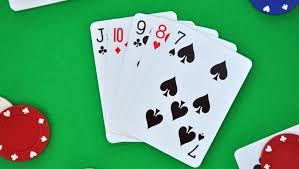Introduction: The Hand That Changed the Game
It was a chilly evening in Las Vegas when Sarah, a budding poker enthusiast, decided to try her luck at the tables for the first time. She had been practicing online for months, learning the rules and strategies, but nothing could have prepared her for the thrill of playing in a live game. As the game progressed, Sarah found herself in a tense standoff against a seasoned player. The flop, turn, and river cards seemed to favor her opponent, but she noticed something that gave her hope—a potential straight. With a slight smirk, she placed her bet, and as the final card revealed itself, Sarah’s hand was made. She had a straight, and the pot was hers. This moment of triumph not only boosted her confidence but also solidified her understanding of one of the most powerful hands in poker.
What Is a Straight in Poker?
A straight in poker is a hand that consists of five consecutive cards of different suits. For example, a hand containing 5, 6, 7, 8, and 9 of any suits forms a straight. The strength of a straight lies in its rarity and the difficulty of forming it during a game. It ranks above three-of-a-kind and below a flush in poker hand rankings. Understanding how to recognize and effectively play a straight can significantly increase a player’s chances of winning, as it is a versatile hand that can turn the tide of a game.
How to Form a Straight
The formation of a straight requires players to have a clear understanding of the sequence of cards. It can be made using any combination of the hole cards and the community cards dealt in games like Texas Hold’em. For instance, if you are dealt 7 and 8, and the community cards include 9, 10, and Jack, you have successfully formed a straight. The lowest possible straight is an A-2-3-4-5, also known as the “wheel” or “bicycle,” and the highest is a 10-J-Q-K-A, referred to as a “broadway.”
Odds of Getting a Straight
The odds of getting a straight depend on the stage of the game and the number of community cards revealed. According to poker statistics, the probability of completing a straight from an open-ended straight draw (where you need one card on either end of your sequence) on the turn is about 17%, and it increases to roughly 31.5% if you’re drawing on both the turn and river. The likelihood of being dealt a straight in Texas Hold’em from the start is approximately 0.3925%, or about 1 in 254 hands.
Strategies for Playing a Straight
Playing a straight requires strategic thinking, as it can be a strong hand but also a vulnerable one, depending on the board and opponents. Here are some tips to keep in mind:
- Assess the Board: Before committing to your straight, evaluate the community cards. If there are possible flush or full house combinations on the board, your straight may be at risk.
- Bet Aggressively in Early Position: If you have a straight early on, consider betting aggressively to force opponents to fold weaker hands and increase the pot size.
- Be Cautious in Late Position: If you’re in a late position and the board shows potential higher straights or flushes, it may be wise to play more conservatively to avoid significant losses.
- Bluff with Caution: While a straight is a strong hand, it’s important not to overplay it, especially if the board shows potential for stronger hands like a flush or full house.
Common Mistakes to Avoid
Even experienced players can make mistakes when dealing with a straight. One common error is overvaluing a straight when the board shows possibilities for higher-ranking hands. Additionally, players sometimes fall into the trap of chasing a straight draw, leading to significant losses if the needed card doesn’t appear. Understanding the risk and potential reward is key to playing a straight effectively.
The Impact of Straights in Poker History
Straights have played pivotal roles in some of the most iconic moments in poker history. For example, in the 2003 World Series of Poker (WSOP), Chris Moneymaker, an amateur player, bluffed his way to victory with a straight, defeating seasoned pro Sam Farha. Moneymaker’s win not only earned him the championship title but also sparked the online poker boom, inspiring millions to try their hand at the game.
Conclusion: Mastering the Straight
Understanding the straight is essential for any poker player looking to improve their game. It’s a hand that can bring significant rewards, but only if played wisely. By recognizing the potential for a straight, calculating the odds, and employing strategic play, you can turn a simple sequence of five cards into a winning hand. Just like Sarah in our story, mastering the straight could be your ticket to success at the poker table.
Also Read: https://casinobolds.co.uk/















Comments